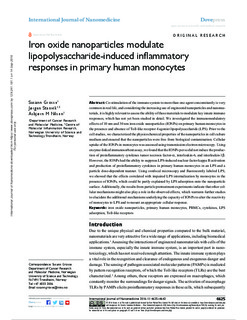| dc.contributor.author | Grosse, Susann | |
| dc.contributor.author | Stenvik, Jørgen | |
| dc.contributor.author | Nilsen, Asbjørn Magne | |
| dc.date.accessioned | 2016-09-14T07:16:25Z | |
| dc.date.accessioned | 2016-09-16T11:15:43Z | |
| dc.date.available | 2016-09-14T07:16:25Z | |
| dc.date.available | 2016-09-16T11:15:43Z | |
| dc.date.issued | 2016 | |
| dc.identifier.citation | International Journal of Nanomedicine 2016, 11:4625-4642 | nb_NO |
| dc.identifier.issn | 1178-2013 | |
| dc.identifier.uri | http://hdl.handle.net/11250/2407799 | |
| dc.description.abstract | Co-stimulation of the immune system to more than one agent concomitantly is very common in real life, and considering the increasing use of engineered nanoparticles and nanomaterials, it is highly relevant to assess the ability of these materials to modulate key innate immune responses, which has not yet been studied in detail. We investigated the immunomodulatory effects of 10 nm and 30 nm iron oxide nanoparticles (IONPs) on primary human monocytes in the presence and absence of Toll-like receptor 4 agonist lipopolysaccharide (LPS). Prior to the cell studies, we characterized the physicochemical properties of the nanoparticles in cell culture medium and ensured that the nanoparticles were free from biological contamination. Cellular uptake of the IONPs in monocytes was assessed using transmission electron microscopy. Using enzyme-linked immunosorbent assay, we found that the IONPs per se did not induce the production of proinflammatory cytokines tumor necrosis factor-α, interleukin-6, and interleukin-1β. However, the IONPs had the ability to suppress LPS-induced nuclear factor kappa B activation and production of proinflammatory cytokines in primary human monocytes in an LPS and a particle dose-dependent manner. Using confocal microscopy and fluorescently labeled LPS, we showed that the effects correlated with impaired LPS internalization by monocytes in the presence of IONPs, which could be partly explained by LPS adsorption onto the nanoparticle surface. Additionally, the results from particle pretreatment experiments indicate that other cellular mechanisms might also play a role in the observed effects, which warrants further studies to elucidate the additional mechanisms underlying the capacity of IONPs to alter the reactivity of monocytes to LPS and to mount an appropriate cellular response. | nb_NO |
| dc.language.iso | eng | nb_NO |
| dc.publisher | Dove Medical Press | nb_NO |
| dc.rights | Navngivelse-Ikkekommersiell 4.0 Internasjonal | |
| dc.rights.uri | http://creativecommons.org/licenses/by-nc/4.0/deed.no | |
| dc.subject | iron oxide nanoparticles, primary human monocytes, PBMCs, cytokines, LPS adsorption, Toll-like receptors | nb_NO |
| dc.title | Iron oxide nanoparticles modulate lipopolysaccharide-induced inflammatory responses in primary human monocytes | nb_NO |
| dc.type | Journal article | nb_NO |
| dc.type | Peer reviewed | nb_NO |
| dc.date.updated | 2016-09-14T07:16:25Z | |
| dc.source.pagenumber | 4625-4642 | nb_NO |
| dc.source.volume | 11 | nb_NO |
| dc.source.journal | International Journal of Nanomedicine | nb_NO |
| dc.identifier.doi | 10.2147/IJN.S113425 | |
| dc.identifier.cristin | 1381143 | |
| dc.description.localcode | © 2016 Grosse et al. This work is published and licensed by Dove Medical Press Limited. The full terms of this license are available at https://www.dovepress.com/terms.php and incorporate the Creative Commons Attribution – Non Commercial (unported, v3.0) License (http://creativecommons.org/licenses/by-nc/3.0/). By accessing the work you hereby accept the Terms. Non-commercial uses of the work are permitted without any further permission from Dove Medical Press Limited, provided the work is properly attributed. For permission for commercial use of this work, please see paragraphs 4.2 and 5 of our Terms (https://www.dovepress.com/terms.php). | nb_NO |

